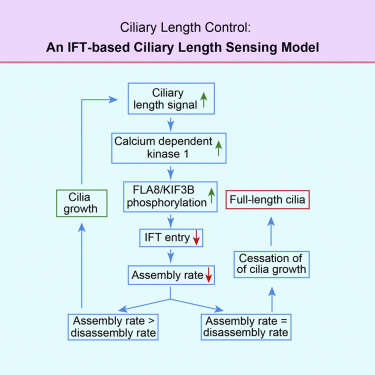Current Biology ( IF 8.1 ) Pub Date : 2018-07-26 , DOI: 10.1016/j.cub.2018.05.069 Yinwen Liang , Xin Zhu , Qiong Wu , Junmin Pan

|
The length of cilia is robustly regulated [1]. Previous data suggest that cells possess a sensing system to control ciliary length [2, 3, 4, 5]. However, the details of the mechanism are currently not known [6, 7]. Such a system requires a mechanism that responds to ciliary length, and consequently, disruption of that response system should alter ciliary length [1]. The assembly rate of cilium mediated by intraflagellar transport (IFT) gradually decreases as the cilium elongates and eventually is balanced by the constant rate of disassembly, at which point cilium elongation stops [8, 9]. Because the rate of IFT entry into the cilium also decreases as the cilium elongates [10], regulation of IFT entry could provide the mechanism for length control. Previously, we showed that phosphorylation of the FLA8/KIF3B subunit of the anterograde kinesin-II IFT motor blocks IFT entry and flagellar assembly in Chlamydomonas [11]. Here, we show in Chlamydomonas that cellular signaling in response to alteration of flagellar length regulates phosphorylation of FLA8/KIF3B, which restricts IFT entry and, thus, flagellar assembly to control flagellar length. Cellular levels of phosphorylated FLA8 (pFLA8) are tightly linked to flagellar length: FLA8 phosphorylation is reduced in cells with short flagella and elevated in cells with long flagella. Depletion of the phosphatases CrPP1 and CrPP6 increases the level of cellular pFLA8, leading to short flagella due to decreased IFT entry. The results demonstrate that ciliary length control is achieved by a cellular sensing system that controls IFT entry through phosphorylation of the anterograde IFT motor.
中文翻译:

睫状体长度传感通过改变FLA8 / KIF3B磷酸化来调节IFT进入,从而控制睫状体的组装
纤毛的长度受到严格调节[1]。先前的数据表明,细胞具有控制睫状体长度的传感系统[2、3、4、5]。然而,该机制的细节目前未知[6,7]。这样的系统需要一种能够响应睫状体长度的机制,因此,该响应系统的破坏会改变睫状体的长度[1]。鞭毛内运输(IFT)介导的纤毛的组装率随着纤毛的延长而逐渐降低,并最终由恒定的分解速率所平衡,这时纤毛的伸长停止了[8,9]。由于IFT进入纤毛的速率也随着纤毛的伸长而降低[10],因此对IFT进入的调节可以提供长度控制的机制。之前,衣藻[11]。在这里,我们在衣藻中显示,响应鞭毛长度改变的细胞信号传导调节FLA8 / KIF3B的磷酸化,从而限制IFT进入,从而限制鞭毛组装以控制鞭毛长度。磷酸化的FLA8(pFLA8)的细胞水平与鞭毛长度紧密相关:鞭毛短的细胞中FLA8的磷酸化降低,鞭毛长的细胞中FLA8的磷酸化升高。磷酸酶CrPP1和CrPP6的耗竭会增加细胞pFLA8的水平,由于IFT进入减少而导致鞭毛短小。结果表明,通过细胞感应系统可实现睫状体长度控制,该系统通过顺行IFT马达的磷酸化来控制IFT进入。





















































 京公网安备 11010802027423号
京公网安备 11010802027423号